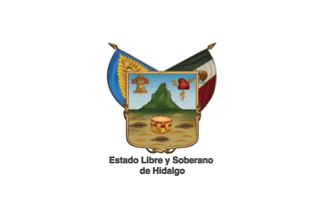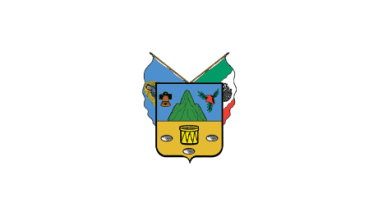Hidalgo (Mexico) (original) (raw)

This page is part of © FOTW Flags Of The World website
Estado Libre y Soberano de Hidalgo
Last modified: 2019-12-14 by juan manuel gabino villascán
Keywords: mexico | hidalgo | state | [unofficial flag](keywordu.html#unofficial flag) | [white background](keywordw.html#white background) |
Links: FOTW homepage |search | disclaimer and copyright | write us | mirrors
[ ](../images/m/mx-hg.gif)
Image by Ivan Sache 24 April 2019.
- Presentation of Hidalgo
- Flags of Hidalgo
- Coat of arms of Hidalgo Municipalities:
- Zempoala See also:
- The states and Mexico City
- Clickable map of Mexican states
- Mexico
Presentation of Hidalgo
- Official name (Spanish): Estado Libre y Soberano de Hidalgo
- Official name (English): Free and Sovereign State of Hidalgo
- Short-form names: State of Hidalgo, Hidalgo
- **Location:**Land-locked stated in center-south of Mexico. It neighborsSan Luis Potosí (N),Veracruz de Ignacio de la Llave (NE),Puebla (E),Tlaxcala (SE),State of Mexico (S), andGuanajuato (W).
- Area: 20,502 km2
- Population: 2,858,359 inhabitants (2015)
- Municipalities: 84
- Capital: Pachuca de Soto
- Statehood: 16 January 1869
- Arms adopted: 14 May 1979
- Other features: The state is named for Miguel Hidalgo y Costilla (1753-1811), hailed as the "Father of the Nation", although the independence of Mexico would be achieved only in 1821 by Agustín de Iturbide (1783-1824).
Sources: SEP, INEGI, Ivan Sache 24 April 2019.
Flags of Hidalgo
[ ](../images/m/mx-hg.gif)
Image by Ivan Sache 24 April 2019.
The flag of Hidalgo is white with the state's coat of arms and its full name, "Estado Libro y Soberano de Hidalgo" beneath.
Photos:www.portalautomotriz.com,aldianoticias.mx,www.cinu.mx,www.protocolo.com.mx
Ivan Sache 24 April 2019.
Unofficial variant
[ ](../images/m/mx-hg!.gif) [
[![[Defacto flag]](http://www.crwflags.com/fotw/misc/fis_defa.gif) ](../flags/xf-fis.html#symb) [
](../flags/xf-fis.html#symb) [![[Non-official proportions]](http://www.crwflags.com/fotw/misc/_~~.gif) ](../flags/flagsymb.html) [
](../flags/flagsymb.html) [![[Design is an acceptable variant]](http://www.crwflags.com/fotw/misc/fis_vari.gif) ](xf-fis.html#symb) [
](xf-fis.html#symb) [![[State flag]](http://www.crwflags.com/fotw/misc/xoxxxx.gif) ](xf-fis.html#fiavcode)
](xf-fis.html#fiavcode)
Flag by Juan Manuel Gabino Villascán, 25 February 2004
Coat of arms from: Banco de México
Another flag is plain white with the state's coat of arms with no text.
Juan Manuel Gabino Villascán, 25 February 2004
Coat of arms of Hidalgo

by Banco de México
Posted by: Juan Manuel Gabino Villascán, November 12, 2004.
The coat of arms of Hidalgo is prescribed by Decree No. 55, issued on 14 May 1979 by the Constitutional Congress of Hidalgo and published on 24 January 1980 in the Hidalgo official gazette.
"The coat of arms designed in 1922 by Diego Rivera based on idea of José Vasconcelos is recognized as the official coat of arms, with the following description: As outer ornaments, two crossed flags, the one on the [heraldic] right side, blue charged in the center with an image of the Guadalupe virgin proper and shining or, which symbolizes the birth of independence, knowing that Padre Hidalgo initiated the insurgent movement with such a flag. On the [heraldic] left side is placed the national flag in full colors and with its official symbols. The shield is composed of two horizontal fields. In the upper field, azure a mountain vert in the center, representing the Hidalgo mountains and its mines, as well. In the same upper field, on the [heraldic] right side, a bronze bell hanging from a timber, as a symbol of the Dolores bell, which was used to proclaim independence. At [heraldic] left, a liberty cap gules decorated with three branches of laurel, as symbols of the freedom and victory obtained in 1821. In the lower field, a war drum in the center, as a symbol of the three great social movements of the country: Independence, Reform, and Revolution. At right, in the center, and at left, three openings in the field, which symbolize mine shafts, representing the main source of income for the state, mining."
www.ordenjuridico.gob.mx
"On the morning of 16 September 1810, the parish priest Miguel Hidalgo y Costilla, Ignacio Allende, and Juan Aldama rang the bell located in the eastern tower of the church of Dolores (today, Dolores Hidalgo,Guanajuato). In 1887, Guillermo Valledo, in charge of festivals at the México Town Hall, decided to officially attend the celebration of the independence from the central balcony of the National Palace, which required the use of the Dolores bell. For ten years, the inhabitants of Dolores concealed the location of the bell, which was eventually transferred to Mexico on 28 June 1896; thousands of people watched the cortege of the bell, which was escorted by Generals Sóstenes Rocha and Ignacio Salas, the journalist Gabriel Villanueva, and Guillermo Valledo. The bell was officially set up on the balcony on 14 September 1896. The Independence Bell is 1.06 m in lower diameter, 77 cm in height and 11 cm in thickness; it is inscribed with 'San Joseph, al 22 de Julio de 1768'"
Campana de Dolores, en Ritos y Retos del Centro Histórico
The designer of the arms is the famous painter and muralist Diego Rivera (1886-1957). The writer, philosopher and politician José Vasconcelos (1882-1959) is known as the "cultural caudillo" of the Mexican Revolution
Ivan Sache, 24 April 2019.
Anything below this line was not added by the editor of this page.